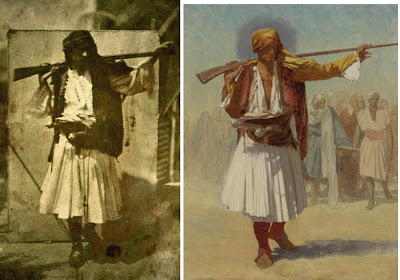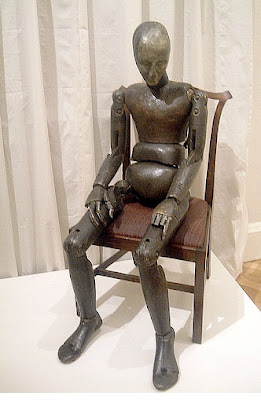Jean-Léon Gérôme painted “
The Grey Eminence” in 1873. It shows a powerful Capuchin friar descending a flight of stairs. He has his nose in a book while worldly nobles ascend the stairs, bowing in homage.
R. Ives Gammell wrote of this work: “No painter today would know the procedures necessary to make such a picture even if he possessed the technical skill to carry them through.” (
Twilight of Painting
)
Mr. Gammell is right. A great deal of the knowledge needed to create such a work has been forgotten. The perspective alone is a daunting prospect. And consider the value-control needed to set up for those slashes of window light. Securing all those models and all those costumes would have been a formidable undertaking, a lot like the job of producing and directing a scene in a modern live action movie.
Once Gérôme had the models and reference, how did he use them? Although he was known to use photography as reference, I don’t think he would have used photos for a richly colored indoor subject such as "The Grey Eminence." He generally preferred to work from observation, as did his contemporaries, such as Ernest Meissonier.
But it’s impossible to get models to hold such long bowing poses and keep the drapery consistent. How did he do it?
I don’t know for sure, but I suspect Gérôme would have used the lay figure here.
In his
Manual of Oil Painting of 1847, based on French sources, John Timbs describes how lay figures were properly used. The artist, Timbs declares, should first pose a living human model in costume.
From that living pose, a rapid sketch in pencil or crayon should be made, capturing the most desirable folds. These ideal folds are almost always the result of accident, and captured in the fleeting moment.
Later, the costume on the lay figure can be arranged to match the model. The artist strives to reproduce the original arrangement, so that it can be copied at leisure. If the artist uses a miniature lay figure, Timbs says, a small wooden stick or knitting needle helps to arrange the tiny folds.
But the lay-figure should be brought in only after the artist has made the guiding sketch from the human model. Using the lay figure as the initial reference was regarded as a bad practice. (Timbs, page 46.)
Philip Alexius de László, a student of John Sargent, concurs. "Once the head and hands are finished, I could, if I wished, complete the draperies and accessories with the help of a model or lay figure, without losing the qualities of the picture, because I have already painted all the main facts of the draperies on the sitter."
When William Bouguereau had himself photographed working in his studio, he had live models posing in the background. Whether he really used only live models, especially children, for the many hours it took to do the painting, or whether he worked from a lay figure, or from photography, is an open question.
Daniel Parkhurst
, a student of Bouguereau, said this about the use of lay figures:
“The use of a lay figure will help you somewhat if you can get one which is true in proportion. It will not help you much in the finer modeling, but it will at least insure your structural lines being in the right place, and that is as much as you can hope for without the special study of the nude."
"A lay figure is expensive," he continues, "costing about three hundred dollars in this country. You will hardly be apt to aspire to a full-sized one, as only professional painters can afford to pay so much for accessories. But small wooden ones are within the means of most people, and will be found useful for the purpose I have mentioned, and one should be obtained.”

"My Favorite Model" by John F. Weir (
Thanks, Greg)
Once photography became well established as a reference tool in the late 19th century, the use of costumed lay figures became less crucial. Artists could now paint from photos of the costumed model. Lay figures gradually fell out of usage, and most practitioners didn’t talk about them anyway, for they were often disparaged. Benjamin Constant’s portrait of Queen Victoria was accused of looking like a "lay figure...arranged in shapeless, incoherent draperies." (
The Nation, Vol. 72)
So as they became less useful, lay figures were discarded, and today the old ones are rather hard to find, either as working props or antique studio bric-a-brac. But I think there should be one in every art school, so that students can study costume patiently from observation.
Well, that’s it for this four part series. If you find more images or links, please pass them along in the comments.
-----
LINKS AND SOURCES
Read the full GurneyJourney series on lay figures:
Part 1











































